American Labor's Untold
Story
by Wm. Schmidt. -
www.tigersoft.com
Today, a young man actually came up to me and asked me what day it was!
I told him it was September 1st. It was Labor Day. It is the day we
should recall
the sacrifices of so many men and women who fought for the rights we now take for
granted: a 40 hour work week, decent pay, over-time pay, work-place safety,
limits on child-labor, the right to form a union for protection without
retailiation...
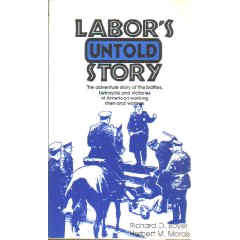
http://www.amazon.com/Labors-Untold-Story-Richard-Boyer/dp/0916180018
Now in its 3rd edition and 26th printing...
Years ago I read a book entitled Labor's Untold Story by Richard O. Buyer
and Herbert Morais. It should be required reading for anyone wanting to understand
American labor history and appreciate the huge sacrifices made for us by so many brave
and disenfrachised workers and union organizers. The rights we now take for
granted
did not spring easily forth from a beneficent government. They had to be fought for.
Capital
was ruthlessly opposed to them. It was indifferent to the plight of those they
exploited.
It believed that its profits depended on continued explotation.
Capital is still ready to abuse its power and run roughtshod over those it employs.
Perhaps, reading about these struggles from 1880 to 1942 here, will allow us to
see that we, too, must pick sides and struggle to achieve such basic human rights as
decent wages, safe working confitons, reasonable job security. retirement benefits,
affordable education and universal health care. If capital says that these goals are
too
expensive, tell them that too much money is wasted by paying CEOs tens of
millions of dollars in salaries and fraudulent bonuses. Tell them to stop the insane
$3 TRILLION WAR in Iraq and spend the savings here at home. Have them
understand the vast human potential this would release for constructive, rather
than destructive purposes Make them see that their biggest market is American
workers and their families. If American workers are not paid reasonably, a
Depression
will surely lie ahead.
The lyrics for "Which Side Are You On." by Florence Reese
Sung by Pete Seeger.
Come all of you good workers
Good news to you I'll tell
Of how that good old union
Has come in here to dwell
(Chorus)
Which side are you on?
Which side are you on?
Which side are you on?
Which side are you on?
Our father was a union man.
Some day ill be one too.
The bosses fired daddy
What's a family gonna do?
(Chorus)
My daddy was a miner
And I'm a miner's son
And I'll stick with the union
Till every battle's won
(Chorus)
They say in Harlan County
There are no neutrals there
You'll either be a union man
Or a thug for J.H. Blair
(Chorus)
Oh, workers can you stand it?
Oh, tell me how you can
Will you be a lousy scab
Or will you be a man?
(Chorus)
Don't scab for the bosses
Don't listen to their lies
Us poor folks haven't got a chance
Unless we organize
(Chorus)
Other organizing songs - Union Maid sung
by Pete Seeger and Arlo Guthrie.
Solidarity
Forever by Pete Seeger
I Dreamed Joe Hill Last Night
sung by Joan Baez
Sacrifices of Organized
Labor
1806 The union of Philadelphia Journeymen Cordwainers was
convicted of and bankrupted by charges of criminal conspiracy after a strike for higher
wages, setting a precedent by which the U.S. government would combat unions for years to
come.
1825 The first strike for the 10-hour work-day occurred by
carpenters in Boston.

1835 Children employed in the silk mills in Paterson, NJ went on
strike for the 11 hour day/6 day week.
1860 800 women operatives and 4,000 workmen marched during a
shoemaker's strike in Lynn, Massachusetts.
1874 The original Tompkins Square Riot. As unemployed
workers demonstrated in New York's Tompkins Square Park, a detachment of mounted police
charged into the crowd, beating men, women and children indiscriminately with billy clubs
and leaving hundreds of casualties in their wake. Commented Abram Duryee, the Commissioner
of Police: "It was the most glorious sight I ever
saw..."
1877 U.S. railroad workers began strikes to protest wage
cuts.
1877 Ten coal-mining activists ("Molly Maguires")
were hanged in Pennsylvania.
1877 A general strike halted the movement of U.S. railroads.
In the following days, strike riots spread across the United States. The next week,
federal troops were called out to force an end to the nationwide strike. At the
"Battle of the Viaduct" in Chicago, federal troops
(recently returned from an Indian massacre) killed 30 workers and wounded over 100.
1884 - The Federation of Organized Trades and Labor Unions,
forerunner of the AFL, passed a resolution stating that "8 hours shall constitute a
legal day's work from and after May 1, 1886." Though the Federation did not intend to
stimulate a mass insurgency, its resolution had precisely that effect. ( http://www.lutins.org/labor.html )
1886 - Haymarket Massacre - May Coordinated strikes and demonstrations are held
nationwide,
to demand an eight-hour workday for industrial workers. McCormick Reaper Works
factory strike; unarmed strikers,
police clash; several strikers are killed. A meeting of workingmen is held near
Haymarket Square; police arrive to "
disperse the peaceful assembly; a bomb is thrown into the ranks of the police; the police
open fire; workingmen
evidently return fire; police and an unknown number of workingmen killed; the bomb thrower
is unidentified. police
arrest anarchist and labor activists. The grand jury indicts 31, charged with being
accessories to the murder of policeman
Mathias J. Degan; eight are chosen to stand trial: Albert Parsons, August Spies, Oscar
Neebe, Louis Lingg, George Engel,
Adolph Fischer, Michael Schwab, Samuel Fielden. Jury selection commences; 981
citizens are questioned during
the voir dire process; the resultant panel of twelve are largely businessmen, clerks or
salesmen; the jurors, like the
public at large, hold preconceived notions about the defendants' connection to the
bombing. Trial testimony begins;
227 testify including 54 members of the Chicago Police Department and the defendants
Fielden, Schwab, Spies and Parsons;
the defendants are prosecuted not as perpetrators but as responsible for instigating the
violence; a guilty verdict and
death sentence are considered inevitable. The jury convicts the defendants and
sentences Neebe to fifteen years
in the penitentiary and the others to death by hanging. 1887 -- Illinois
Supreme Court upholds rulings and verdict.
November 2, 1887 -- The U.S. Supreme Court denies an appeal, despite an
international campaign for clemency.
Louis Lingg commits suicide in his jail cell. November 11, 1887 --
Albert Parsons,
August Spies, George Engel, Louis Lingg and Adolph Fischer were executed.
They had organized for an 8-hour day and were framed for their efforts.
( http://www.fullbooks.com/Labor-s-Martyrs.html
)
---------------------------------------------------------------------------------------------------------------------------
"If
you think that by hanging us you can stamp out the labor movement," Spies told the
judge,
"then hang us. Here you will tread upon a spark, but here, and there, and behind you,
and in front of
you, and everywhere, the flames will blaze up. It is a subterranean fire. You cannot put
it out.
The ground is on fire upon which you stand." ( http://members.tripod.com/~RedRobin2/index-54.html
)
---------------------------------------------------------------------------------------------------------------------------
November 13, 1887 -- In Chicago,
the funeral procession of Lingg, Parsons, Spies, Engel, and Fischer in Chicago
is witnessed by 150,000 - 500,000 people. June 26, 1893 - Illinois governor John
Peter Altgeld pardons Neebe,
Fielden, and Schwab.
( http://memory.loc.gov/ammem/award98/ichihtml/hayhome.html
)
1892 - Strike in the Coeur d'Alene mining region of northern Idaho,
unionists discover a company plant,
Charles Siringo. Trouble ensues, with union men dynamiting a mill and capturing 130
non-union workers
and holding them prisoner in a union hall. Several persons are killed by gunfire. Over 400
union men
commandeer a train and take it to Wardner , Idaho, where they seize three mines, ejecting
non-union
workers and company officials. Governor Willey declares martial law and asks President
Benjamin
Harrison to send federal troops, which he does. The strike grew out of the mine owners'
decision to reduce
wages for certain workers from 35 cents an hour to 30 cents. Federal troops arrest
600 union men and
sympathizers, placing them in warehouses surrounded by 14-foot high fences. For two
months, the men
are kept without hearing or formal charges, then most are released. Union leaders are
tried.
1892 - Homestead Strike - lockout and strike which
began on June 30, 1892, culminating in a battle
between strikers and private security agents on July 6, 1892. It is one of the most
serious labor disputes
in U.S. history. The dispute occurred in the Pittsburgh-area
town of Homestead, Pennsylvania, between
the Amalgamated Association of Iron
and Steel Workers (the AA) and the Carnegie
Steel Company.
The AA was an American labor union formed in 1876. A craft union, it represented skilled iron and steel workers.
The AA's membership was concentrated in ironworks west of the Allegheny
Mountains. The union negotiated national
uniform wage scales on an annual basis; helped regularize working hours, workload levels
and work speeds;
and helped improve working conditions. It also acted as a hiring hall,
helping employers find scarce puddlers and rollers.[1]
The AA was an American labor union formed in 1876. A craft union, it represented skilled iron and steel workers.
The AA's membership was concentrated in ironworks west of the Allegheny
Mountains. The union negotiated
national uniform wage scales on an annual basis; helped regularize working hours, workload
levels and work
speeds; and helped improve working conditions. It also acted as a hiring hall,
helping employers find scarce puddlers
and rollers.[1]
With the collective bargaining agreement due to expire on June 30, 1892, Frick and the leaders
of the local AA union entered into negotiations in February. With the steel industry doing
well and prices higher,
the AA asked for a wage increase. Frick immediately countered with a 22 percent wage
decrease that would
affect nearly half the union's membership and remove a number of positions from the
bargaining unit. Carnegie
encouraged Frick to use the negotiations to break the union: "...the Firm has decided
that the minority must give
way to the majority. These works, therefore, will be necessarily non-union after the
expiration of the present
agreement."[11]
Frick then unilaterally announced on April 30, 1892
that he would bargain for 29 more days.
If no contract was reached, Carnegie Steel would cease to recognize the union. Carnegie
formally approved
Frick's tactics on May 4.[12]
Frick locked workers out of the plate mill
and one of the open hearth furnaces on the evening of June 28.
When no collective bargaining agreement was reached on June 29, Frick locked the
union out of the rest
of the plant. A high fence topped with barbed wire, begun in January, was completed and
the plant sealed to
the workers. Sniper towers with searchlights were constructed near each mill building, and
high-pressure
water cannons (some capable of spraying boiling-hot liquid) were placed at each entrance.
Various aspects
of the plant were protected, reinforced or shielded.[13]
At a mass meeting on June
30, local AA leaders reviewed the final negotiating sessions and announced
that the company had broken the contract by locking out workers a day before the contract
expired.
The Knights
of Labor, which had organized the mechanics and transportation workers at Homestead,
agreed
to walk out alongside the skilled workers of the AA. Workers at Carnegie plants in Pittsburgh, Duquesne,
Union Mills and Beaver Falls struck in sympathy the same day.[14]
The striking workers were determined to keep the plant closed. They secured a
steam-powered river launch
and several rowboats to patrol the Monongahela
River, which ran alongside the plant. Men also divided
themselves into units along military lines. Picket lines were thrown up around the plant
and the town, and 24-hour
shifts established. Ferries and trains were watched. Strangers were challenged to give
explanations for their presence
in town; if one was not forthcoming, they were escorted outside the city limits. Telegraph
communications with AA
locals in other cities were established to keep tabs on the company's attempts to hire
replacement workers. Reporters
were issued special badges which gave them safe passage through the town, but the badges
were withdrawn if it
was felt misleading or false information made it into the news. Tavern owners were even
asked to prevent excessive
drinking.[15]
Frick was also busy. The company placed ads for replacement workers in newspapers as
far away as Boston, St. Louis
and even Europe.[16]
But unprotected strikebreakers would be driven off. On July 4, Frick formally
requested that
Sheriff William H. McCleary intervene to allow supervisors access to the plant. Carnegie
corporation attorney
Philander Knox gave the go-ahead to the sheriff on July 5, and McCleary
dispatched 11 deputies to the town to
post handbills ordering the strikers to stop interfering with the plant's operation. The
strikers tore down the handbills
and told the deputies that they would not turn over the plant to nonunion workers. Then
they herded the deputies
onto a boat and sent them downriver to Pittsburgh.[17]
After consultations with Knox, Frick in April 1892 had contracted with the Pinkerton National Detective Agency
to provide security at the plant. His intent was to open the works with nonunion men on July 6. Knox devised a plan
to get the Pinkertons onto the mill property. With the mill ringed by striking workers,
the agents would access the
plant grounds from the river. Three hundred Pinkerton agents assembled on the Davis Island
Dam on the Ohio
River about five miles below Pittsburgh at 10:30 p.m. on the night of July 5, 1892. They were given Winchester
rifles, placed on two specially-equipped barges and towed upriver.[18]
The strikers were prepared for them. The AA had learned of the Pinkertons as soon as
they had left Boston for
the embarkation point. The strikers blew the plant whistle at 2:30 a.m., drawing thousands
of men, women and
children to the plant. The small flotilla of union boats went downriver to meet the
barges. Strikers on the steam
launch fired a few random shots at the barges, then withdrew—blowing the launch
whistle to alert the plant.[19]
The Pinkertons attempted to land under cover of darkness about 4 a.m. A large crowd of
families had kept pace
with the boats as they were towed by a tug into the town. A few shots were fired at the
tug and barges, but no one
was injured. The crowd tore down the barbed-wire fence and strikers and their families
surged onto the Homestead
plant grounds. Some in the crowd threw stones at the barges, but strike leaders shouted
for restraint.[20]
The Pinkerton agents attempted to disembark. Conflicting testimony exists as to which
side fired the first shot.
According to unnamed and unidentified witnesses,[citation needed] Pinkertons shot
first. According to witnesses
who gave their names and identities, unionists shot first[21].
Frederick Heinde, captain of the Pinkertons, and William Foy, a worker, were both
wounded. The Pinkerton
agents aboard the barges then fired into the crowd, killing two and wounding 11. The crowd
responded in kind,
killing two and wounding 12. The firefight continued for about 10 minutes.[22]
The strikers then huddled behind the pig and scrap iron in the mill yard while the
Pinkertons cut holes in the side
of the barges so they could fire on any who approached. The Pinkerton tug departed with
the wounded agents,
leaving the barges stranded. The strikers soon set to work building a rampart of steel
beams further up the riverbank
from which they could fire down on the barges. Hundreds of women continued to crowd on the
riverbank between
the strikers and the agents, calling on the strikers to 'kill the Pinkertons'.[23]
The strikers continued to sporadically fire on the barges. Union members took potshots
at the ships from their
rowboats and the steam-powered launch. The burgess of Homestead, John McLuckie, issued a proclamation at
6:00 a.m. asking for townspeople to help defend the peace; more than 5,000 people
congregated on the hills
overlooking the steelworks. A 20-pounder brass cannon was set up on the shore opposite the
steel mill, and an
attempt was made to sink the barges. Six miles away in Pittsburgh, thousands of
steelworkers gathered in the streets,
listening to accounts of the attacks at Homestead; hundreds, many of them armed, began to
move toward the town
to assist the strikers.[24]
The Pinkertons attempted to disembark again at 8:00 a.m. A striker high up the
riverbank fired a shot. The
Pinkertons returned fire, and four more strikers were killed (one by shrapnel sent flying
when cannon fire hit one
of the barges). Many of the Pinkerton agents refused to participate in the firefight any
longer; the agents crowded
onto the barge farthest from the shore. More experienced agents were barely able to stop
the new recruits from
abandoning the ships and swimming away. Intermittent gunfire from both sides continued
throughout the morning.
When the tug attempted to retrieve the barges at 10:50 a.m., gunfire drove it off. More
than 300 riflemen positioned
themselves on the high ground and kept a steady stream of fire on the barges. Just before
noon, a sniper shot
dead another Pinkerton agent.[25]
After a few more hours, the strikers attempted to burn the barges. They seized a raft,
loaded it with oil-soaked
timber and floated it toward the barges. The Pinkertons nearly panicked, and a Pinkerton
captain had to threaten
to shoot anyone who fled. But the fire burned itself out before it reached the barges. The
strikers then loaded a
railroad flatcar with drums of oil and set it afire. The flatcar hurtled down the rails
toward the mill's wharf where
the barges were docked. But the car stopped at the water's edge and burned itself out.
Dynamite was thrown at
the barges, but it only hit the mark once (causing a little damage to one barge). At 2:00
p.m., the workers poured
oil onto the river, hoping the oil slick would burn the barges; attempts to light the
slick failed.[26]
The AA worked behind the scenes to avoid further bloodshed and defuse the tense
situation. At 9:00 a.m.,
outgoing AA international president William Weihe rushed to the sheriff's office and asked
McCleary to
convey a request to Frick to meet. McCleary did so, but Frick refused. He knew that the
more chaotic the
situation became, the more likely it was that Governor Robert
E. Pattison would call out the state militia.[27]
Sheriff McCleary resisted attempts to call for state intervention until 10 a.m. on July 7. In a telegram to
Gov. Pattison, he described how his deputies and the Carnegie men had been driven off, and
noted that the
mob was nearly 5,000-strong. Pattison responded by requiring McCleary to exhaust every
effort to restore
the peace. McCleary asked again for help at noon, and Pattison responded by asking how
many deputies
the sheriff had. A third telegram, sent at 3:00 p.m., again elicited a response from the
governor exhorting
McCleary to raise his own troops.[28]
At 4:00 p.m., events at the mill quickly began to wind down. More than 5,000 men—most
of them armed
mill hands from the nearby South Side, Braddock and Duquesne works—arrived at the
Homestead plant.
Weihe urged the strikers to let the Pinkertons surrender, but he was shouted down. Weihe
tried to speak again.
But this time, his pleas were drowned out as the strikers bombarded the barges with
fireworks left over from
the recent Independence Day celebration. Hugh O'Donnell,
a heater in the plant and head of the union's strike
committee, then spoke to the crowd. He demanded that each Pinkerton be charged with
murder, forced to turn
over his arms and then be removed from the town. The crowd shouted their approval.[29]
The Pinkertons, too, wished to surrender. At 5:00 p.m., they raised a white flag and
two agents asked to
speak with the strikers. O'Donnell guaranteed them safe passage out of town. As the
Pinkertons crossed
the grounds of the mill, the crowd formed a gauntlet through which the agents passed. Men
and women
threw sand and stones at the Pinkerton agents, spat on them and beat them. Several
Pinkertons were clubbed
into unconsciousness. Members of the crowd ransacked the barges, then burned them to the
waterline.[30]
As the Pinkertons were marched through town to the Opera House (which served as a
temporary jail), the
townspeople continued to assault the agents. Two agents were beaten as horrified town
officials looked on.
The press expressed shock at the treatment of the Pinkerton agents, and the torrent of
abuse helped turn media
sympathies away from the strikers.[31]
The strike committee met with the town council to discuss the handover of the agents to
McCleary. But the
real talks were taking place between McCleary and Weihe in McCleary's office. At 10:15
p.m., the two
sides agreed to a transfer process. A special train arrived at 12:30 a.m. on July 7.
McCleary, the international
AA's lawyer and several town officials accompanied the Pinkerton agents to Pittsburgh.[32]
But when the Pinkerton agents arrived at their final destination in Pittsburgh, state
officials declared that they
would not be charged with murder (as per the agreement with the strikers) but rather
simply released.
The announcement was made with the full concurrence of the AA attorney. A special train
whisked the
Pinkerton agents out of the city at 10:00 a.m. on July 7.[33]
On July 7, the strike committee sent a telegram to Gov. Pattison to attempt to persuade
him that law and order
had been restored in the town. Pattison replied that he had heard differently. Union
officials traveled to Harrisburg"
and met with Pattison on July
9. Their discussions revolved not around law and order, but the safety of the
Carnegie plant.[34]
Pattison, however, remained unconvinced by the strikers' arguments. Although Pattison
had ordered the
Pennsylvania militia to muster on July 6, he had not formally charged it with doing
anything. Pattison's refusal to
act rested largely on his concern that the union controlled the entire city of Homestead
and commanded the
allegiance of its citizens. Pattison refused to order the town taken by force, for fear a
massacre would occur.
But once emotions had died down, Pattison felt the need to act. He had been elected with
the backing of a
Carnegie-supported political machine, and he could no longer refuse to protect Carnegie
interests.[35]
The steelworkers resolved to meet the militia with open arms, hoping to establish good
relations with the troops.
But the militia managed to keep its arrival in the town a secret almost to the last
moment. At 9:00 a.m. on July
12,
the Pennsylvania state militia arrived at the small Munhall train station near the
Homestead mill (rather than the
downtown train station as expected). More than 4,000 soldiers surrounded the plant. Within
20 minutes they
had displaced the picketers; by 10:00 a.m., company officials were back in their offices.
Another 2,000 troops
camped on the high ground overlooking the city.[36]
The company quickly brought in strikebreakers and restarted production under the
protection of the militia.
Despite the presence of AFL pickets in front of several recruitment offices across the
nation, Frick easily found
employees to work the mill. The company quickly built bunk houses, dining halls and
kitchens on the mill grounds
to accommodate the strikebreakers. New employees, many of them black, arrived on July 13, and the mill
furnaces
relit on July 15. When
a few workers attempted to storm into the plant to stop the relighting of the furnaces,
militiamen fought them off and wounded six with bayonets.[37]
The company could not operate for long with strikebreakers living on the mill grounds,
and permanent replacements had to be found.
Legal retaliation against the strikers proved to be the most promising avenue for the
company. On July 18, 16
of the strike leaders were charged with conspiracy, riot and murder. Company lawyer Knox
drew up the charges on behalf of state authorities. Each man was jailed for one night and
forced to post a $10,000 bond. The union retaliated by charging company executives with
murder as well. The company men, too, had to post a $10,000 bond, but they were not forced
to spend any time in jail. The same day, the town was placed under martial law, further
disheartening many of the strikers.[39]
National attention became riveted on Homestead when, on July 23, Alexander
Berkman, an anarchist, gained
entrance to Frick's office, shot him twice in the neck and then stabbed him twice with a
knife. Berkman was
convicted of attempted murder and sentenced to 22 years in prison.[40]
The Berkman incident prompted the final collapse of the strike. Hugh O'Donnell, without
consulting his colleagues on the strike committee, offered what amounted to unconditional
surrender to the company
Additional legal ammunition against the strikers was levied in the fall. Knox had engaged
in ex parte
communication with Pennsylvania Supreme Court Chief Justice
Edward Paxson. Knox submitted charges to Paxson which accused all 33 members of the strike
committee with treason under the state's Crimes Act of 1860. In Pittsburgh for the court's
fall term, Paxson (after conferring with Knox once more) issued the treason charges
himself on August 30.
A $500,000 bond was required. Most of the men could not raise the money, and went to jail
while awaiting trial; a few simply went into hiding. Legal scholars were outraged by clear
abuse of the law, and deeply concerned by Paxson's apparently biased behavior. State
prosecutors, worried by the flimsy nature of the charges, declined to prosecute.[42]
Support for the strikers evaporated. The AFL refused to call for a boycott of Carnegie
products in September 1892. Wholesale crossing of the picket line occurred, first among
Eastern European immigrants and then among all workers. The strike had collapsed so much
that the state militia pulled out on October 13, ending the 95-day occupation. The AA was nearly
bankrupted by the job action. Nearly 1,600 men were receiving a total of $10,000 a week in
relief from union coffers. With only 192 out of more than 3,800 strikers in attendance,
the Homestead chapter of the AA voted, 101 to 91, to return to work on November 20, 1892.[43]
In the end, only four workers were ever tried on the actual charges filed on July 18.
Three AA members were found innocent of all charges. Hugh Dempsey, the leader of the local
Knights of Labor District Assembly, was found guilty of conspiring to poison nonunion
workers at the plant—despite the state's star witness recanting his testimony on the
stand. Dempsey served a seven-year prison term. In February 1893, Knox and the union agreed
to drop the charges filed against one another, and no further prosecutions emerged from
the events at Homestead.[44
The Homestead strike broke the AA as a force in the American labor movement. Many
employers refused to
sign contracts with their AA unions while the strike lasted. ( http://en.wikipedia.org/wiki/Homestead_Strike
)
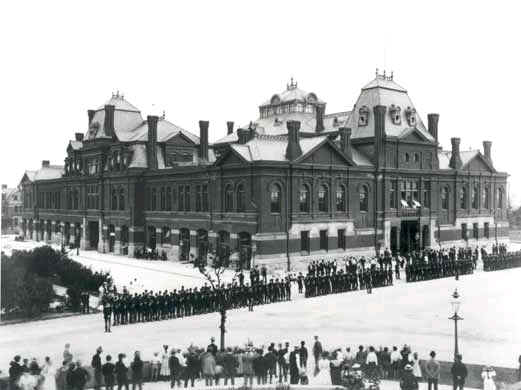
Illinois
National Guard can be seen guarding the building during the Pullman During Railroad Strike
in 1894.
1894 - 2,000 federal troops were called into Pullman, Ill.,
to break up a huge
strike against the Pullman railway company and two workers were shot and
killed by U.S. deputy marshals. The Pullman Strike occurred when 4,000 Pullman Palace
Car
Company workers reacted to a 28% wage cut by going on a wildcat strike
in Illinois on May 11, 1894, bringing
traffic west of Chicago to a halt. George Pullman
was a "welfare capitalist." Firmly believing that labor
unrest
was caused by the unavailability of decent pay and living conditions, he paid
unprecedented wages and built a
company town
by Lake Calumet
called Pullman in what is now the southern part of the city. George Pullman
was a "welfare capitalist." To reduce labor unrest , he paid
unprecedented wages and built a company town by
Lake Calumet
called Pullman in what is now the southern part of the city
During the economic panic of 1893, the Pullman Palace Car Company cut wages as
demands for their
train cars plummeted and the company's revenue dropped. A delegation of workers complained
that
the corporation that operated the town of Pullman didn't decrease rents, but Pullman
"loftily declined to talk with them."[3]
Many of the workers were already members of the American
Railway Union (ARU), led by Eugene V. Debs,
which supported their strike by launching a boycott in which union members refused to run
trains containing
Pullman cars. The strike effectively shut down production in the Pullman factories and led
to a lockout.
Railroad workers across the nation refused to switch Pullman cars (and subsequently Wagner Palace cars)
onto trains. The ARU declared that if switchmen were disciplined for the boycott, the
entire ARU would strike
in sympathy.[3]
The boycott was launched on June 26, 1894. Within four days, 125,000 workers on
twenty-nine railroads
had quit work rather than handle Pullman cars.[3]
Adding fuel to the fire the railroad companies began hiring
replacement workers (that is, strikebreakers), which only increased hostilities. Many African
Americans,
fearful that the racism expressed by the American
Railway Union would lock them out of another labor
market crossed the picket line to break the strike, adding a racially charged tone to the
conflict.[4]
On June 29, 1894, Debs hosted a peaceful gathering to obtain support for the strike
from fellow
railroad workers at Blue Island, Illinois. Afterward groups within the crowd became
enraged and set fire
to nearby buildings and derailed a locomotive. Elsewhere in the United States, sympathy
strikers prevented
transportation of goods by walking off the job, obstructing railroad tracks or threatening
and attacking
strikebreakers. This increased national attention to the matter
and fueled the demand for federal action.[5]
The railroads were able to get Edwin Walker, general counsel for the Chicago, Milwaukee
and St. Paul Railway,
appointed as a special federal attorney with responsibility for dealing with the strike.
Walker obtained an
injunction barring union leaders from supporting the strike and demanding that the
strikers cease their activities
or face being fired. Debs and other leaders of the ARU ignored the injunction, and federal
troops were called
into action.[6]
The strike was broken up by United States Marshals and some 12,000 United
States Army troops, commanded
by Nelson Miles, sent in by President Grover
Cleveland on the premise that the strike interfered with the delivery
of U.S. Mail, ignored a federal injunction and
represented a threat to public safety. The arrival of the military led
to further outbreaks of violence. During the course of the strike, 13 strikers were killed
and 57 were wounded.
An estimated 6,000 rail workers did $340,000 worth of property damage (about $6,800,000
adjusted for inflation
to 2007). Debs was then tried for, and eventually found guilty of violating the
court injunction, and was sent to
prison for six months.[7]
A national commission formed to study causes of the 1894 strike found
Pullman's
paternalism partly to blame and Pullman's company town to
be "un-American." In 1898, the Illinois Supreme
Court forced the Pullman Company to divest ownership in the town, which was annexed to
Chicago.
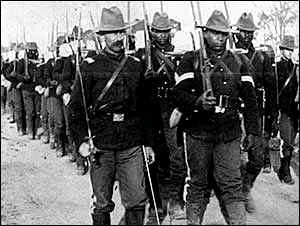 Federal troops frequently
were needed in Idaho, 1892 and 1899. Federal troops frequently
were needed in Idaho, 1892 and 1899.
Miners in Idaho fought mine owners and their private militias. The Western
Federation of Miners
was created in the wake of the 1892 episode of violence, where miners are arrested and
imprisoned;
and while they were in federal prison, they talked about what has happened to them, and
they
decided they never wanted that to happen to them again, and they created the union.
With tragic consequences, the Governor and local officials paid little attention to
workers'
complaints of dangerous mining conditions and low pay and sided with the mine owners'
dogma that "private property" was the most important concern.
1899 - Union miners plant 60 boxes of dynamite
beneath the world's largest concentrator,
owned by the Bunker Hill Mining Company in Wardner, Idaho, and at 2:35 p.m. light the
fuse,
destroying the concentrator and several nearby buildings. Governor
Steunenberg calls upon
President McKinley to send federal troops to suppress the unrest. Federal troops
arrest
"every male--miners, bartenders, a doctor, a preacher, even a postmaster and a school
superindentent--" in the union-controlled town of Burke, Idaho. The men are loaded
into
boxcars, taken to Wardner, and herded into an old barn. Within a few days, the number
of men held captive in Wardner grows to over 1, 000.
1902
- Anthracite
Coal Strike
1904 - In the midst of a violent labor dispute, a railroad
depot in Independence, Colorado is
bombed, presumably under orders from the leaders of the Western Federation of Miners,
killing
fourteen non-union miners.
1905 - Idaho: Returning to his home in Caldwell from a walk
shortly after six p.m..
Frank Steunenberg, the former governor of Idaho, is blown ten
feet in the air by a
bomb blast as he opens his gate and dies soon afterwards. Later, a waitress at the
Saratoga Hotel in Caldwell reports that a guest, Thomas Hogan, had trembling hands and
downcast eyes when she waited on his table shortly after the explosion. A search of
Hogan's
room turns up traces of plaster of paris in his chamber pot. Plaster of paris was the
substance
used to hold pieces of the bomb together. January 1, 1906: Thomas Hogan, also
known as
Harry Orchard, is arrested while having a drink at the Saratoga Bar and is charged with
the
first degree murder of Steunenberg. January 7, 1906: The state of Idaho hires
America's
most famous detective, James McParland of the Pinkerton Detective Agency, to head the
investigation of Steunenberg's assassination. He arrives in Boise two days later.
January 22, 1906: McParland meets Orchard in the state penitentiary and suggests
that more lenient treatment might be possible if were willing to turn state's evidence
against those who recruited him to commit his crime. February 1, 1906: Harry Orchard,
after breaking down several times and crying, completes a 64-page confession to the
Steunenberg assassination and 17 other killings, all ordered, he says, by the inner
circle of the Western Federation of Miners, including William Haywood, Charles Moyer,
and George Pettibone. February 15, 1906: Governor McDonald of Colorado issues
a
warrant for the arrest of Haywood, Moyer, and Pettibone. February 17, 1906:
Late at night, Haywood, Moyer, and Pettibone are arrested in Denver and temporarily
housed in a local jail. February 18, 1906: Denied an opportunity to call
lawyers or
loved ones, the three union leaders are placed on a special train at daybreak. Orders are
issued that the train not stop until it has crossed the Idaho border.
April, 1906: The Supreme Court of Idaho rules that it has no jurisdiction to hear the
complaint of Haywood, Moyer, and Pettibone that they were denied an opportunity
to fight extradition to Idaho. November, 1906: William Haywood loses his race
as
the Socialist Party candidate for Governor of Colorado. December 3,
1906: The Supreme
Court of the United States, with one dissent, rules that the union leaders' arrest and
forcible removal from Colorado, even though accomplished through the fraud and
connivance of leaders of two states, violated no constitutional rights of the defendants.
1907: Adams repudiates his confession and is transferred to Wallace, Idaho to stand
trial for an 1899 murder. The jury is unable to reach a verdict. Hayward an
Pettibone
are also acquitted by juries and the charges against Charles Moyer are dropped. 1908:
Harry Orchard is tried and convicted of the murder of Gov.
Steunenberg. He is sentenced
to death, but his sentence is commuted to life in prison.
(Source: http://www.law.umkc.edu/faculty/projects/ftrials/haywood/HAY_CHRO.HTM
1909 - NYC - 30,000 garment workers go on on strike.
As young as age 15, they are
worked seven days
a week, from 7 a.m. to 8 p.m. (53 hour work week) with a half-hour lunch
break. During the busy season, the work was nearly non-stop. They were paid about $6
per week.
In some cases, they were required to use their own needles, thread, irons and occasionally
their own sewing machines. Owners hired thugs to break up striking women. Police
back
the owners and arrest strkers. Judges quickly sentenced them to Labor
Camps. One judge
said their strike went against God's will.
( http://www.aflcio.org/aboutus/history/history/uprising_fire.cfm
)
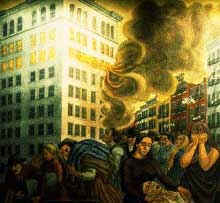
March 25, 1911, a Saturday, a fire broke out on
the top floors of the Triangle Shirtwaist
factory. Firefighters arrived at the scene, but their ladders weren’t tall enough to
reach the upper
floors of the 10-story building. Trapped inside because the owners had locked the fire
escape exit
doors, workers jumped to their deaths. In a half an hour, the fire was over, and 146
of the 500 workers—mostly young women—were dead...After the fire, their story
inspired hundreds of
activists across the state and the nation to push for fundamental reforms. For some,
such as
Frances Perkins, who stood helpless watching the factory burn, the tragedy inspired a
lifetime of advocacy for workers’ rights. She later became secretary of labor
under President Franklin D. Roosevelt.
Company owners were charged with
seven counts of manslaughter – but were found
not guilty. The incident was a turning point in labor law, especially concerning health
and safety.
For three days prior, the company, along with other warehouse owners, had grouped together
to
fight the Fire Commissioner's order that fire sprinklers be installed.
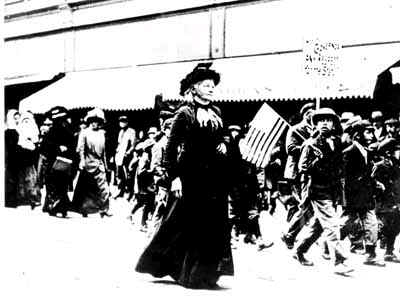
Mother Jones and Workers seeking to
organize a union.
She
sometimes took jobs in factories to understand the problems of workers,
or lived with them in tents. The workers
often were immigrants who spoke little
English and had no knowledge of how to
improve their lives in America. She gave
inspiring speeches that boosted their
spirits, or she held educational meetings.
Sometimes
she was a volunteer, sometimes she was paid for her work.
In 1877, working among railroad workers
in Pittsburgh, she organized her first
strike. In 1890, she took a job as an
organizer for the United Mine Workers.
In 1902, she led a march of coal miners'
wives against strikebreakers in
Pennsylvania. The next year, she led
"the march of the mill children"
from Pennsylvania to Long Island to protest child labor.
In 1912, at age 82, she endured arrest
and trial to fight for striking coal miners
in West Virginia. During the strike,
shooting had erupted between the miners
and guards hired to protect substitute
workers. Martial law was declared.
When Mother Jones went to Charleston, the
capital, to meet the governor,
she was arrested. A military prosecutor
indicted her and 47 others on the union
side -- none of the guards were charged
-- with conspiracy to commit murder.
( http://www.dailypress.com/topic/ny-sbp_62503x,0,6512878.story
)
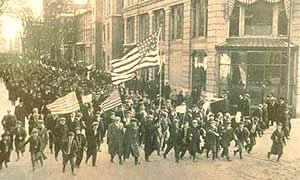
1912 -
Lawrence, Mass. strikers' victory parade.
1912 - Lawrence
Textile Strike - A strike of immigrant workers in Lawrence, Massachusetts
in 1912 led by the Industrial Workers of the World. Work in a
textile mill takes place at a grueling pace. The labor is repetitive, and dangerous.
A number of children under the age of fourteen worked in the mills. Conditions
had grown even worse for workers in the decade before the strike. The introduction
of the two-loom system in the woolen mills lead to a dramatic speedup in the pace
of work. The increase in production enabled the factory owners to cut the wages
of their employees and lay off large numbers of workers. Those who kept their jobs
earned less than $9.00 a week for nearly sixty hours of work. The workers in
Lawrence
lived in crowded and dangerous apartment buildings, often with many families
sharing each apartment. Many families survived on bread, molasses, and beans;
as one worker testified before the March 1912 congressional investigation of the
Lawrence strike, "When we eat meat it seems like a holiday, especially for the
children".
The mortality
rate for children was fifty percent by age six; thirty-six out of every
100 men and women who worked in the mill died by the time they reached twenty-five.
Prompted by one mill owner's decision to lower wages when a new law shortening
the workweek went into effect in January, the strike spread rapidly through the town,
growing to more than twenty thousand workers at nearly every mill within a week.
The strike, which lasted more than two months and which defied the assumptions
of conservative unions within the American Federation of Labor that immigrant,
largely female and ethnically divided workers could not be organized.
When Polish women weavers at Everett Cotton Mills realized that their employer had
reduced their pay by thirty two cents they stopped their looms and left the mill,
shouting
"short pay, short pay!" Workers at other mills joined the next day; within
a week more
than 20,000 workers were on strike.
Joseph
Ettor of the IWW had been organizing in Lawrence for some time before the strike;
he and Arturo Giovannitti of the IWW quickly assumed leadership of
the strike, forming a
strike committee made up of two representatives from each ethnic group in the mills,
which took responsibility for all major decisions. The committee, which arranged for
its
strike meetings to be translated into twenty-five different languages, put forward a
set of
demands; a fifteen percent increase in wages for a fifty-four-hour work week, double
time
for overtime work, and no discrimination against workers for their strike activity.
The City responded to the strike by ringing the city's alarm bell for the first
time in its history;
the Mayor ordered a company of the local militia to patrol the streets. The strikers
responded
with mass picketing. When mill owners turned fire hoses on the picketers gathered in
front of
the mills, they responded by throwing ice at the plants, breaking a number of
windows. The
court sentenced thirty-six workers to a year in jail for throwing ice; as the judge
stated, "The
only way we can teach them is to deal out the severest sentences". The governor
then ordered
out the state militia and state police. Mass arrests followed.
A local undertaker and a member of the Lawrence school board
attempted to frame the strike leadership
by planting dynamite in several locations in town a week after the strike began. He was
fined $500
and released without jail time. William Wood, the owner of the American Woolen Company,
who had
made a large payment to the defendant under unexplained circumstances shortly before the
dynamite
was found, was not charged.
The authorities later charged Ettor and Giovannitti with murder for the death of striker Anna LoPizzo,[1]
likely
shot by the police. Ettor and Giovannitti had been three miles away, speaking to another
group of workers
at the time. They and a third defendant, who had not even heard of either Ettor or
Giovannitti at the time
of his arrest, were held in jail for the duration of the strike and several months
thereafter. The authorities
declared martial law, banned all public meetings and called out twenty-two more militia
companies to patrol
the streets.
The IWW responded by sending Bill Haywood, Elizabeth
Gurley Flynn and a number of other organizers
to Lawrence. The union established an efficient system of relief committees, soup
kitchens, and food distribution
stations, while volunteer doctors provided medical care. The IWW raised funds on a
nation-wide basis to provide
weekly benefits for strikers and dramatized the strikers' needs by arranging for several
hundred children to go to
supporters' homes in New York City for the duration of the strike. When city
authorities tried to prevent another
hundred children from going to Philadelphia on February 24 by
sending police and the militia to the station to
detain the children and arrest their parents, the police began clubbing both the children
and their mothers while
dragging them off to be taken away by truck; one pregnant mother miscarried. The press,
there to photograph
the event, reported extensively on the attack.
The public assault on the children and their mothers sparked a national outrage. Congress
convened investigative
hearings, eliciting testimony from teenaged workers who described how they had to pay for
their drinking water
and to do unpaid work on Saturdays. Helen
Herron Taft, the wife of President Taft,
attended the hearings; Taft later
ordered a nationwide investigation of factory conditions.
The national attention had an effect: the owners offered a five percent pay raise on March 1; the workers
rejected it. American Woolen Company agreed to all the strikers' demands on March 12, 1912. The rest
of the
manufacturers followed by the end of the month; other textile companies throughout New England,
anxious to
avoid a similar confrontation, followed suit. The children who had been taken in by
supporters in New York
City came home on March
30.
Ettor and Giovannitti remained in prison even after the strike ended. Haywood
threatened a general strike
to demand their freedom, with the cry "Open the jail gates or we will close the mill
gates". The IWW raised $60,000
for their defense and held demonstrations and mass meetings throughout the country in
their support; the authorities
in Boston, Massachusetts arrested all of the members of the
Ettor-Giovannitti Defense Committee. Fifteen
thousand Lawrence workers went on strike for one day on September 30 to
demand that Ettor and Giovannitti
be released. Swedish and French workers proposed a boycott of woolen goods from the United
States and a refusal
to load ships going to the U.S.; Italian supporters of Giovannitti rallied in front of the
United States consulate in Rome.
In the meantime, Ernest Pitman, a Lawrence building contractor who had done extensive
work for the American
Woolen Company, confessed to a district attorney that he had attended a meeting in the
Boston offices of Lawrence
textile companies where the plan to frame the union by planting dynamite had been made.
Pitman committed suicide
shortly thereafter when subpoenaed to testify. Wood, the owner of the American Woolen
Company, was formally
exonerated.
When the trial of Ettor, Giovannitti, and a co-defendant accused of firing the shot
that killed the picketer, began in
September 1912 in Salem, Massachusetts before Judge Joseph F.
Quinn, the three defendants were kept in metal
cages in the courtroom. Witnesses testified without contradiction that Ettor and
Giovannitti were miles away while
Caruso, the third defendant, was at home eating supper at the time of the killing.
Ettor and Giovannitti both delivered closing statements at the end of the two-month
trial. Joe Ettor stated:
- Does the District Attorney believe that the gallows or
guillotine ever settled an idea?
If an idea can live, it lives because history adjudges it right. I ask only for justice. .
. .
The scaffold has never yet and never will destroy an idea or a movement. . . .
An idea consisting of a social crime in one age becomes the very religion of humanity in
the next. . . .
Whatever my social views are, they are what they are. They cannot be tried in this
courtroom..
All three defendants were acquitted on November 26, 1912.
The strikers, however, lost nearly all of the gains they had won in the next few years.
The IWW disdained written
contracts, holding that such contracts encouraged workers to abandon the daily class
struggle. In fact, however,
the mill owners had more stamina for that fight and slowly chiseled away at the
improvements in wages and
working conditions, while firing union activists and installing labor spies to keep an eye
on workers. A
depression in the industry, followed by another speedup, led to further layoffs. The IWW
had, by that time,
turned its attention to supporting the silk industry workers in Paterson,
New Jersey. The Paterson strike
ended in defeat.
( http://en.wikipedia.org/wiki/Lawrence_textile_strike
)
1913-14 - Calumet, Michigan
Copper Strike. Strike called by Western Federation of Miners
because mine owners would not recognize the union. Boys 12 years old worked in
the mine. Murder,
assault, intimidation followed. strikers demanded that two men be involved in the
operation of all equipment
for the sake of worker safety, demands for an 8 hour work day instead of 12 hours,
recognition of the union,
a minimum wage of $3 for underground workers, and a pay increase of 35 cents per day for
all surface workers.
WFM claimed nine thousand members in the region, with 98% of them voting in favor of the
strike. sheriff of
Houghton County, James Cruse, ontracted men from the Waddell-Mahon agency of New York.
These strike
breakers were well known to the WFM, having been involved in other strikes supported by
the union in the
western U.S. Waddell-Mahon men, as well as Ascher detectives, were also hired. Mine
owners refused to
recognize WFM and tried to use strike breakers (scabs)to start up mines.
Local newsapers refused to tell
the miners' side of strike, blaming them for all acts of violence.
The strike had started in July. It was not settled by the end of the year. At a
Christmas Party of 500
hundred miners's families, someone yelled "fire". In the ensuing melee
seventy-three people (including
fifty-nine children) were killed. There was no fire. To date it has not been established
who cried "fire"
and why. The most common theory is that "fire" was called out by the anti-union
company management
to disrupt the party. It was also claimed that the doors has been bolted shut by scabs.
The companies' anti union organziation, Citizens Allianc, sought to have Charles
Moyer, president of the
Western Federation of Miners, publicly exonerate
the Alliance of all fault in the tragedy. Moyer refused.
Rather than provide such an exoneration, Moyer announced that the Alliance was responsible
for the
catastrophe, claiming that an Alliance agent yelled the word “fire”.[3]
The Alliance assaulted Moyer in
nearby Hancock,
shot and kidnapped
him. They placed him on a train with instructions to leave the state
and never return. After getting medical attention in Chicago (and holding a press conference where he
displayed his gunshot wound) he returned to Michigan to continue the work of the
WFM.
( http://en.wikipedia.org/wiki/Italian_Hall_Disaster
http://www.hu.mtu.edu/vup/Strike/background3.html.
)
1914 - Ludlow, Colorado Massacre
- This was the most violent labor conflict in U.S. history;
the reported death toll was nearly 200 It began withe deaths of 20 people, 11
of them children,
during an attack by the Colorado National Guard on a tent colony of 1,200 striking coal
miners and their
families at Ludlow, Colorado in the U.S. on April 20, 1914.
These deaths occurred after a day-long fight
between strikers
and the Guard. Two women, twelve children, six miners and union officials and one
National Guardsman were killed. In response, the miners armed themselves and attacked
dozens of
mines, destroying
property and engaging in several skirmishes with the Colorado National Guard.
This was the bloodiest event in the 14-month 1913-1914 southern Colorado Coal
Strike. The strike
was organized by the United Mine Workers of America
(UMWA) against coal
mining companies in Colorado. The three biggest mining companies were the Rockefeller
family-owned
Colorado Fuel & Iron
Company (CF&I), the Rocky Mountain Fuel Company (RMF), and the Victor-American
Fuel Company (VAF)
Mining firms had long been able to attract low-skill labor, in spite of modest wages and stiff cost-cutting
policies designed to maintain profits
in a competitive industry. This made conditions in the mines difficult and
often dangerous for the workers, and the sector became a ripe target for union organizers.
Colorado miners
had attempted to periodically unionize since the state's first strike in
1883.
The Western Federation of Miners organized primarily
hard rock miners in the gold and silver camps
during the 1890s. Beginning in 1900, the UMWA began organizing coal
miners in the western states,
including southern Colorado. The UMWA decided to focus on the CF&I because of the
company's
harsh management tactics under the conservative and distant Rockefellers
and other investors. As part of their
campaign to break or prevent strikes, the coal companies had lured immigrants, mainly
from southern
and
Eastern
Europe and Mexico.
CF&I's management purposely mixed immigrants of different nationalities
in the mines to discourage communication that might lead to organization.
As was typical in the industry of that day, miners were paid by tons of coal mined and
not reimbursed for
"dead work," such as laying rails, timbering, and shoring the mines to make them
operable. Given the
intense pressure to produce, mine safety was often given short shrift. More than 1,700
miners died in
Colorado from 1884 to 1912, a rate that was between 2 and 3.5 times the national average
during
those years. Furthermore, the miners felt they were being short-changed on the weight of
the coal they
mined, arguing that the scales used for paying them were different from those used for
coal customers.
Miners challenging the weights risked being dismissed.
Most miners also lived in "company towns," where homes, schools, doctors, clergy, and
law enforcement
were provided by the company, as well as stores offering a full range of goods that could
be paid for in
company currency, scrip.
However, this became an oppressive environment in which law focused on
enforcement of increasing prohibitions on speech
or assembly by the miners to discourage union-building
activity. Also, under pressure to maintain profitability, the mining companies steadily
reduced their investment
in the town and its amenities while increasing prices at the company store so that miners
and their families
experienced worsening conditions and higher costs. Colorado's legislature had
passed laws
to improve the
condition of the mines and towns, including the outlawing of the use of scrip, but these
laws were poorly enforced.
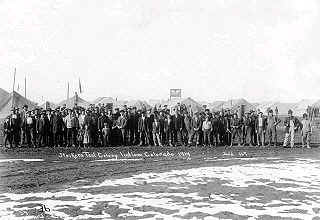
Despite attempts to suppress union activity, secret organizing continued by the UMWA in
the years leading
up to 1913. Once everything had
been laid out according to their plan, the UMWA presented, on behalf
of coal miners, a list of seven demands:
- - Recognition of the union as bargaining agent
- - An increase in tonnage rates (equivalent to a 10% wage increase)
- - Enforcement of the eight-hour work day law
- - Payment for "dead work" (laying track, timbering, handling impurities, etc.)
- - Weight-checkmen elected by the workers (to keep company weightmen honest)
- - The right to use any store, and choose their boarding houses
and doctors
- - Strict enforcement of Colorado's laws (such as mine safety rules, abolition of scrip),
and an end to the dreaded company guard system
The major coal companies rejected the demands and in September 1913, the UMWA called a
strike.
Those who went on strike were promptly evicted from their company homes, and they moved to
tent villages
prepared by the UMWA, with tents built on wood platforms and furnished with cast iron
stoves on land leased
by the union in preparation for a strike.
In leasing the tent village sites, the union had strategically selected locations near
the mouths of the canyons,
which led to the coal camps for the purpose of monitoring traffic and harassing
replacement workers. Confrontations
between striking miners and replacement workers, referred to as "scabs" by
the union, often got out of control,
resulting in deaths. The company hired the Baldwin-Felts
Detective Agency to help break the strike by protecting
the replacement workers and otherwise making life difficult for the strikers.
Baldwin-Felts had a reputation for aggressive strike breaking. Agents shone searchlights on the tent villages
at night and randomly fired into the tents, occasionally killing and maiming people. They
used an improvised
armored car, mounted with a M1895 Colt-Browning machine gun that the union
called the "Death Special,"
to patrol the camp's perimeters. The steel-covered car was built in the CF&I plant in Pueblo
from the chassis
of a large touring sedan. Because of frequent sniping on the tent colonies, miners dug
protective pits beneath
the tents where they and their families could seek shelter.
On October 28,
as strike-related violence mounted, Colorado
governor Elias M. Ammons, called in the
Colorado National Guard. At first, the guard's appearance calmed the situation. But the
sympathies of the
militia leaders were quickly seen by the strikers to lie with company management. Guard
Adjutant General John
Chase had served during the violent Cripple Creek strike 10 years earlier, and
imposed a harsh regime in Ludlow.
|On March 10, 1914, the body of a replacement
worker was found on the railroad tracks near Forbes.
The National Guard believed that the man had been murdered by the strikers. Chase ordered
the Forbes
tent colony destroyed in retaliation. The attack was carried out while the Forbes colony
inhabitants were
attending a funeral of infants who had died a few days earlier. The attack was witnessed
by a young
photographer, Lou Dold, whose images of the
destruction appear often in accounts of the strike.
The strikers persevered until the spring of 1914. By then, the state had run out of
money to maintain the guard,
and was forced to recall them. The governor and the mining companies, fearing a breakdown
in order,
left two guard units in southern Colorado and allowed the coal companies to finance a
residual militia, which
consisted largely of CF&I camp guards in National Guard uniforms.
On the morning of April
20, the day after Easter was celebrated by the many Greek immigrants at Ludlow,
three Guardsmen appeared at the camp ordering the release of a man they claimed was being
held against his will.
This request prompted the camp leader, Louis Tikas, born in Crete, to meet with a local militia commander
at the train station in Ludlow village, a half mile (0.8 km) from the colony. While this
meeting was progressing,
two companies of militia installed a machine gun on a ridge near the camp and took a
position along a rail route
about half a mile south of Ludlow. Anticipating trouble, Tikas ran back to the camp. The
miners, fearing for the
safety of their families, set out to flank the militia positions. A firefight soon broke
out.
he fighting raged for the entire day. The militia was reinforced by non-uniformed mine
guards later in the afternoon.
At dusk, a passing freight train stopped on the tracks in front of the Guards'
machine gun placements,
allowing many of the miners and their families to escape to an outcrop of hills to the
east called the "Black Hills."
By 7:00 p.m., the camp was in flames, and the militia descended on it and began to search
and loot the camp.
Louis Tikas had remained in the camp the entire day and was still there when the fire
started. Tikas and two
other men were captured by the militia. Tikas and Lt. Karl Linderfelt, commander of one of two Guard companies,
had confronted each other several times in the previous months. While two militiamen held
Tikas, Linderfelt broke
a rifle butt over his head. Tikas and the other two captured miners were later found shot
dead. Their bodies lay
along the Colorado and Southern tracks for three days in full view of passing trains. The
militia officers refused
to allow them to be moved until a local of a railway union demanded the bodies be taken
away for burial.
During the battle, four women and eleven children had been hiding in a pit beneath one
tent, where they were
trapped when the tent above them was set on fire. Two of the women and all of the children
suffocated. These
deaths became a rallying cry for the UMWA, who called the incident the "Ludlow
Massacre."[1]
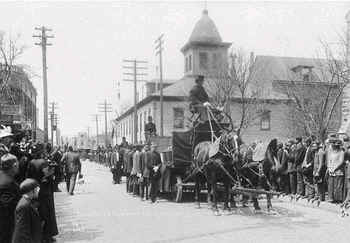
Coffins are marched
through Trinidad, Colorado, at the funeral for victims of the Ludlow massacre
In addition to the fire victims, Louis Tikas and the other men who were shot to death,
three company guards
and one militiaman were also killed in that day's fighting.
n response to the Ludlow massacre, the leaders of organized labor in Colorado issued a call to arms,
urging union members to acquire "all the arms and ammunition legally available,"
and a large-scale guerrilla war
ensued, lasting ten days. In Trinidad, Colorado, UMW officials openly distributed arms
and ammunition to strikers
at union headquarters. Believing their women and children to have been "wantonly
slaughtered" by the militia,
700 to 1,000 inflamed strikers "attacked mine after mine, driving off or killing the
guards and setting fire to the
buildings." At least fifty people, including those at Ludlow, were killed in ten days
of fighting against mine guards
and hundreds of militia reinforcements rushed back into the strike zone. The fighting
ended only when U.S.
President Woodrow
Wilson sent in federal troops.[2] The
troops disarmed both sides (displacing, and often
arresting, the militia in the process) and reported directly to
Washington.
The UMWA finally ran out of money, and called off the strike on December 10, 1914.
In the end, the strikers failed to obtain their demands, the union did not obtain
recognition, and many striking
workers were replaced by new workers. Over 400 strikers were arrested, 332 of whom were
indicted for
murder. Only one man, John Lawson, leader of the strike, was convicted of murder, and that
verdict was
eventually overturned by the Colorado Supreme Court. Twenty-two National Guardsmen,
including 10 officers,
were court-martialed.
All were acquitted, except Lt. Linderfelt, who was found guilty of assault for his attack
on Louis Tikas. However, he was given only a light reprimand.
The UMWA eventually bought the site of the Ludlow tent colony in 1916. Two years later,
they erected
the Ludlow
Monument to commemorate those who had died during the strike. .A company union was
established by John Rockerfeller, Jr. ( http://en.wikipedia.org/wiki/Ludlow_massacre
)
1916 - Everett (WA) Massacre
- On May 1, 1916 the Everett Shingle Weavers Union went on strike.
Strike-breakers had beaten the picketers, and the police did not get
involved, on the grounds that the mill
was on private property. At the end of the shift, the picketers
retaliated, but this time the police intervened,
IWW public speakers protested the unequal treatment. Realizing that
arrest alone did not serve as a deterrent
to the speakers, the police now began beating the speakers the
arrested. They ran I.W.W. members out of town,
and prohibited entrance to town, merely for being members. The
I.W.W. began bringing members to town in
groups, but the police (enlisting the aid of citizen-deputies) beat the
groups, as well. The worst of these beatings
was on October 30, 1916. Forty-one I.W.W. members had come by ferry to
Everett, to speak at Hewitt and
Wetmore. The Sheriff and his deputies beat these men, took them to Beverly
Park, and forced them to run
through a gauntlet of 'law and order' officials, armed with clubs and whips.
It was this horrific incident which
caused the I.W.W. to organize a group of 300 men to travel to Everett on
November 5 for a free-speech rally.
Five workers were killed. Thirty wounded. Nearly 300 were arrested,
. ( http://content.lib.washington.edu/cdm4/document.php?CISOROOT=/pnwlabor&CISOPTR=10&CISOSHOW=195
)
On November 5, 1916,
about 300 members of the IWW met at the IWW hall in Seattle
and then marched down
to the docks where they boarded the steamers Verona and Calista
which then headed north to Everett.
Verona arrived at Everett before Callista and as they
approached the dock in the early afternoon, the Wobblies
sang their fight song Hold the Fort. Local business interests,
knowing the Wobblies were coming, placed
armed vigilantes on the dock and on at least one tugboat in the harbor,
Edison, owned by the American
Tug Boat Company.[2] As
with previous labor demonstrations, the local business had also secured the aid
of law enforcement, including the Snohomish County sheriff Donald
McRae, who had targeted Wobblies for
arbitrary arrests and beatings.[3]
At the end of the mayhem, 2 citizen deputies lay dead with 16[9] or 20
others wounded, including Sheriff McRae.
The IWW officially listed 5 dead with 27 wounded, although it is
speculated that as many as 12 IWW members
may have been killed. There was a good likelihood that at least some of
the casualties on the dock were caused
not by IWW firing from the steamer, but on vigilante rounds from the
cross-fire of bullets coming from the
Edison.[10] The
local Everett Wobblies started their street rally anyway, and as a result, McRae's
deputized
citizens rounded them up and hauled them off to jail.[11] As a result of the shootings, the governor of the State of
Washington sent companies of militia to Everett and Seattle to help maintain
order.[12]
Upon returning to Seattle,
74 Wobblies were arrested as a direct result of the "Everett
Massacre" including IWW leader Thomas H. Tracy.
They were taken to the Snohomish County jail in Everett and charged with
murder of the 2 deputies. After a
two-month trial, Tracy was acquitted by a jury on May 5, 1917. Shortly
thereafter, all charges were dropped
against the remaining 73 defendants and they were released from jail.
(Source: http://en.wikipedia.org/wiki/Everett_massacre
)
-----------------------------------------------------------------------------------------------------
Historians Philip Taft and Philip Ross have pointed out in their
comments on violence in labor history
that
"IWW activity was virtually free of violence... It is of some interest to note that a
speaker who
advocated
violence at a meeting at the IWW hall in Everett [Washington] was later exposed as a
private
detective."[13]
-----------------------------------------------------------------------------------------------------
As a result, over 200 vigilantes or "citizen deputies", under the ostensible
authority of Snohomish County Sheriff McRae,
met in order to repel the "anarchists". As the Verona drew into the dock, and
someone on board threw a line over a
bollard, McRae stepped forward and called out "Boys, who's your leader?" The IWW
men laughed and jeered,
replying "We're all leaders," and they started to swing out the gang plank.
McRae drew his pistol, told them he was
the sheriff, he was enforcing the law, and they couldn't land here. There was a silence,
then a Wobbly came up to
the front and yelled out "the hell we can't."[4]
Just then a single shot rang out, followed by about ten minutes of intense gunfire.
Most of it came from the vigilantes
on the dock, but some fire came from the Verona, although the majority of the
passengers were unarmed.[5].
Whether the first shot came from boat or dock was never determined. Passengers aboard the Verona
rushed
to the opposite side of the ship, nearly capsizing the vessel. The ship's rail broke as a
result and a number of passengers
were ejected into the water, some drowned as a result but how many is not known, or
whether persons who'd
been shot also went overboard.[6] Over
175 bullets pierced the pilot house alone, and the captain of the Verona,
Chance Wiman, was only able to avoid being shot by ducking behind the ship's safe.[7]
Once the ship righted herself somewhat after the near-capsize, some slack came on the
bowline, and Engineer
Shellgren put the engines hard astern, parting the line, and enabling the steamer to
escape. Out in the harbor,
Captain Wiman warned off the approaching Calista and then raced back to Seattle.[8]
1917 - Bisbee Copper Mine Deportation
- 1,185 other men were herded into filthy boxcars by an
armed vigilante force in Bisbee, Arizona, and abandoned across the New Mexico border.
During World
War I, the price of copper reached unprecedented heights and the companies reaped enormous
profits. By
March of 1917, copper sold for $.37 a pound; it had been $.13 1/2 at the outbreak of World
War I in 1914.
With five thousand miners working around the clock, Bisbee was booming. To maintain
high production levels,
the pool of miners was increased from an influx of southern European immigrants. Although
the mining
companies paid relatively high wages, working conditions for miners were no
better than before the copper
market crash in 1907-1908. Furthermore, the inflation caused by World War I increased
living expenses and
eroded any gains the miners had realized in salaries. The mining companies
controlled Bisbee, not only
because they were the primary employers but because local businesses depended heavily on
the mines and
miners to survive. Even the local newspaper was owned by one of the major mining
companies, Phelps Dodge.
Prior to 1917, union activity had repeatedly been stifled. Between 1906 and 1907, for
example, about 1,200
men were fired for for supporting a union. Conversely, the Bisbee Industrial Association,
an alliance that was
pro-company and anti-union, was easily organized around the same time.
On June 24, 1917, the I.W.W. presented the Bisbee mining companies with a list of demands.
These
demands included improvements to safety and working conditions, such as requiring two men
on each
machine and an end to blasting in the mines during shifts. Demands were also made to end
discrimination
against members of labor organizations and the unequal treatment of foreign and minority
workers.
Furthermore, the unions wanted a flat wage system to replace sliding scales tied to the
market price
of copper. The copper companies refused all I.W.W. demands, using the war effort as
justification.
As a result, a strike was called, and by June 27 roughly half of the Bisbee work force was
on strike.
The Citizen's Protective League, an anti-union organization formed during a previous labor
dispute,
was resurrected by local businessmen and put under the control of Sheriff Harry Wheeler. A
group of
miners loyal to the mining companies also formed the Workman's Loyalty League. On July 11,
secret meetings of these two so-called "vigilante groups" were held to discuss
ways to deal with the
strike and the strikers.
The next day, starting at 2:00 a. m., calls were made to Loyalty Leaguers as far away as
Douglas,
Arizona. By 5:00 a. m., about 2,000 deputies assembled. All wore white armbands
to distinguish
them from other mining workers. No federal or state officials were notified of the
vigilantes' plans.
The Western Union telegraph office was seized, preventing any communication to the town.
At 6:30 a. m., Sheriff Harry Wheeler gave orders to begin the roundup. Throughout
Bisbee, men were roused
from their beds, their houses, and the streets. Though armed, the vigilantes were
instructed to avoid violence.
However, reports of beatings, robberies, vandalism, and abuse of women later surfaced.
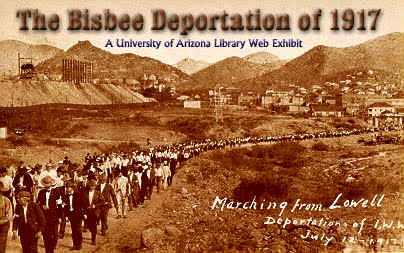
The vigilantes rounded up over 1,000 men, many of whom were not strikers -- or even
miners --
and marched them two miles to the Warren Ballpark. There they were surrounded by armed
Loyalty Leaguers
and urged to quit the strike. Anyone willing to put on a white armband was released. At
11:00 a. m. a train arrived,
and 1,186 men were loaded aboard boxcars inches deep in manure. Also boarding were 186
armed guards; a
machine gun was mounted on the top of the train. The train traveled from Bisbee to
Columbus, New Mexico,
where it was turned back because there were no accommodations for so many men. On its
return trip the train
stopped at Hermanas, New Mexico, where the men were abandoned. A later train brought water
and food rations,
but the men were left without shelter until July 14th when U. S. troops arrived. The
troops escorted the men to
facilities in Columbus. Many were detained for several months.
Meanwhile, Bisbee authorities mounted guards on all roads into town to insure that no
deportees returned and to
prevent new "troublemakers" from entering. A kangaroo court was also established
to try other people deemed
disloyal to mining interests. These people also faced deportation. (Quoted from - http://www.library.arizona.edu/exhibits/bisbee/history/overview.html
)
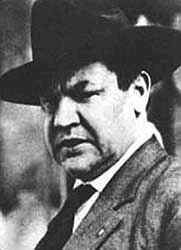
1918: The trial of 101 Wobblies (members of
the Industrial Workers
of the World or IWW) began in Chicago, for opposition to World War I.
In September 1917, 165 IWW members were arrested for conspiring
to hinder the draft, encourage desertion, and intimidate others in connection
with labor disputes. The trial lasted five months, the longest criminal trial
in American history to date. The jury found them all guilty. The judge
sentenced IWW leader "Big Bill" Haywood and 14 others to 20 years"
in prison; 33 were given 10 years, the rest shorter sentences. They were
fined a total of $2,500,000 and the IWW was shattered as a result.
( http://www.peacebuttons.info/E-News/peacehistorymarch.htm
)
1918, 1919 Centralia (WA) Attack on IWW Hall - International Workers of the World
(the IWW, or Wobblies) had set up office in Centralia, Washington, with the intent to
organize the local
labor forces. This was opposed by the wealthy timber barons who made every attempt to
drive them out of town.
On Memorial Day in 1918 during a parade that included the Governor of Washington, the
Mayor of Centralia,
and other dignitaries, the IWW hall was attacked. The IWW office was destroyed and the
workers were
beaten and told to leave town. Instead, they opened a new hall and continued their efforts
toward improving the
living standards of the working class.
The next year a rumor was
circulating that the IWW hall would again be attacked, this time during the Armistice Day
parade. The IWW workers were determined to defend their rights and property, and on the
advice of their
lawyer did so. When the Armistice Day parade stopped in front of the IWW hall, the people
inside were armed
and ready.
The hall was attacked, mainly by
ex-servicemen who were now organized under the American Legion.
As the attackers broke out the windows and kicked in the door, the armed I.W.W. members
fired on them from inside the hall and from a near-by hillside. As a result, several of
the
attackers were either killed or injured.
Wesley Everest, who was one of the
armed IWW members defending the hall, ran out the back
as he was being chased by a mob. He shot three of the attackers, and killed at least one
of them
before he was caught, beaten, and dragged by the neck to the jail. Once there, he was
thrown
in along with the others that had been caught.
Later that day word was received
that several of those shot by the IWW members had died.
This inflamed the community even more. The jail where the prisoners were being held was
surrounded by a large crowd of up to a thousand men and women yelling and cursing at the
prisoners.
Later that night all power went out
in Centralia, and in the darkness Everest was taken from the
jail and hung by the neck from a bridge across the Chehalis River (the Mellen St. Bridge).
It was also rumored that he had been castrated... Later, the I.W.W. members who were
accused of murder in this case, were railroaded by a trial that made a mockery of justice
through lies, intimidation of witnesses, and suppression of evidence.
(Quoted from http://freepages.genealogy.rootsweb.ancestry.com/~cainhome/remmen_album/emil_guard/centralia_tragedy.htm

1919 - Seattle General Strike -
The strike began in shipyards that had
expanded rapidly
with war production contracts. 35,000 workers expected a post-war pay hike to make up
for two years of strict wage controls imposed by the federal
government. When regulators
refused, the Metal Trades Council union alliance declared a strike and closed
the yards.
After an appeal to Seattle’s powerful Central Labor Council for help, most of
the city’s
110 local unions voted to join a sympathy walkout. Most of the local
and national press
denounced the strike, while conservatives called for stern measures to suppress what
looked
to them to be a revolutionary plot. Mayor Ole Hanson, elected the year before with
labor support,
armed the police and threatened martial law and federal troops. Some of the unions
wavered
on the strike's third day. Most others had gone back to work by the time the Central
Labor
Council officially declared an end on February 11. By then police and vigilantes were
hard at
work rounding up Reds. The IWW hall and Socialist Party headquarters were raided and
leaders arrested. Federal agents also closed the Union Record, the
labor-owned daily newspaper,
and arrested several of its staff. Meanwhile across the country headlines screamed
the news
that Seattle had been saved, that the revolution had been broken, that, as Mayor
Hanson phrased it, “Americanism” had triumphed over “Bolshevism.”.
( Source: http://depts.washington.edu/labhist/strike/
)
1920 - Matewan Massacre - In the coal company town of Matewan,
West Virginia,
the miners
miners had begun to organize themselves into a union. The Stone Mountain Coal
Company heavily
resisted this effort from the coal miners by hiring agents from the Baldwin-Felts Detective Agency
to evict them from their company-owned houses.[1]
Matewan Police Chief Sid Hatfield argued
over these illegal evictions
carried out by the Baldwin-Felts detectives. After the argument,
Hatfield obtained warrants for the arrest of the detectives and confronted them at
the town train
depot accompanied by a large group of armed miners some of whom had been temporarily
deputized. When Hatfield presented his warrant, the detectives presented him with a
false
warrant for his own arrest. As the altercation over the two warrants escalated, one
of the miners
in the crowd summoned Matewan mayor Cabell Testerman to settle the dispute. Testerman
declared the warrant for Hatfield's arrest a forgery and within moments, the first
shot was fired.
Although it is not clear who fired first, Mayor Testerman and Albert Felts of the
Baldwin-Felts
agency were the first men to be shot. After the initial shots, the surrounding area
erupted with
gunfire from both sides.
---------------------------------------------------------------------------------------------------------------
Court Testimony
Hatfield: Three automobiles. The mayor issued a warrant for their arrest and
gave it to me and told me to arrest them. I went up and told Mr. Felts, he was the
boss of the gang, that I would have to arrest him. He said he would return the
compliment on me, that he had a warrant for me. I told him to read the warrant to
me. He did not read the warrant to me but told me what the charges were and he said
he would have to take me to Bluefield. I told him that I would not go to Bluefield
because I was the Chief of Police and I could not leave. He told me that he would
have to take me anyway. I told him that if he would have to take me I would have to
be arrested, and the mayor came out to see what the charges were. He asked what the
charges were and he told Felts that he would give bond for me, that he could not afford to
let me go to Bluefield. Felt told him that he could not take any bond, and the mayor
asked him for the warrant, and he gave the warrant to the mayor. The mayor said it
was bogus, it was not legal, and then he shot the mayor. Then the shooting started
in general.
Chairman: How many shots
were fired?
Hatfield: Fifty or
seventy-five.
Chairman: How many men did
you have with you?
Hatfield: I did not have any men
with me at the time they had me arrested. It was train time and a whole lot of
people would meet the train.
Chairman: Did the people
come in to help you arrest them?
Hatfield: I didn’t ask for
any help.
Chairman: How many people were
killed there?
Hatfield: Ten, and four
shot.
Chairman: Ten killed and four
injured.
Hatfield: Yes sir.
Chairman: Of the ten killed, how
many were the Baldwin-Felts people?
Hatfield: Seven.
Chairman: And the other
three were who?
Hatfield: Bob Mullins.
Chairman: One was the
mayor?
Hatfield: Yes sir.
Chairman: Who were the
other two?
Hatfield: Bob Mullins and
Tod Pinsley (Tot Tinsley)
Chairman: Were they
citizens of the town?
Hatfield: Yes sir.
Chairman: Did you know whether
the Baldwin-Felts people had been employed in these labor troubles?
Hatfield: Mr. Smith, the
superintendent of Stone Mountain told us the Baldwin-Felts people were coming.
Chairman: Are you a member
of the United Mine Workers?
Hatfield: No sir.
Chairman: Have you ever
been a miner?
Hatfield: Yes sir.
Chairman: Or a member of
any of their organizations?
Hatfield: No sir. Nothing
only the Odd Fellows and K. P. and Redman.
Chairman: Were there any
troubles after that at Matewan or in that immediate vicinity growing out of the labor
situation?
Hatfield: Not that I
remember of right at the present.
Chairman: You were indicted
yourself, Mr. Hatfield?
Hatfield: Yes sir.
Chairman: And you have been
tried?
Hatfield: Yes sir. I
was tried on one occasion.
Chairman: Were you
acquitted?
Hatfield: Yes sir.
Senator McKellar: Let me
see if I understand you. You say that on this particular day you were the marshal of
that little town and the mayor directed you to arrest these seven or eight men who were
armed?
Hatfield: Thirteen men.
McKellar: Thirteen men?
Hatfield: Yes sir.
McKellar: And the mayor had
directed you to arrest them for what? What were they doing?
Hatfield: We had an
ordinance for nobody to have a gun unless he is an officer.
McKellar: And these 13 men
were there with guns?
Hatfield: Yes sir.
McKellar: And in that way
they were violating the town ordinance?
Hatfield: Yes sir.
McKellar: Now, let me ask
you, how did it happen that the mayor instructed you to arrest them?
Hatfield: I asked him for a
warrant.
McKellar: You asked him for
a warrant?
Hatfield: Yes sir.
McKellar: You had seen
these men there?
Hatfield: Yes sir.
They came through the town – through the back streets in automobiles.
McKellar: When you first
saw them, when you first talked with them, did they say anything about arresting you?
Hatfield: No sir. Not when
I first talked with them.
McKellar: They did not say
anything about arresting you until you attempted to arrest them?
Hatfield: No sir.
McKellar: And then, as I
understand you, they said, “Why, we have a warrant for you?”
Hatfield: Yes sir.
McKellar: Did they show the
warrant?
Hatfield: They didn’t
show it to me.
McKellar: How did they
happen to shoot the mayor?
Hatfield: When he told them
the warrant was bogus and they got up an argument there.
McKellar: Who shot him?
Hatfield: Albert Felts.
McKellar:
Was that the only provocation he had, because the mayor of the city told him that was a
bogus warrant?
Hatfield:
Well, there had been some argument about throwing people out, over them throwing them out,
but that was what was said then he was shot.
McKellar:
That was what was said when he was shot?
Hatfield:
Yes sir.
(Source: http://www.livelyroots.com/things/celively.htm
---------------------------------------------------------------------------------------------------------------
The battle resulted in the deaths of seven Baldwin-Felts
"detectives" [2]as
well as
two miners and Mayor Testerman[3]. The
battle quickly became famous among
miners who celebrated the heavy casualties inflicted on the Baldwin-Felts detectives
and viewed Sid Hatfield as a hero. he surviving agents of the Baldwin-Felts
agency
and its leader, Tom Felts, vowed revenge on Sid Hatfield. On August 1, 1921,
Baldwin-Felts detectives assassinated Sid Hatfield as well as one of Sid's friends
Ed Chambers, outside the McDowell County, West Virginia courthouse in Welch,
West Virginia. The Baldwin-Felts detectives were never arrested or charged for
the crime.
Shortly after the Battle of Matewan and the assassination of Sid Hatfield, coal miners
from across West Virginia gathered in Charleston, West Virginia. Determined to
organize the southern coalfields, they began a march to Logan County. Thousands
of miners joined them along the way in what became the largest armed insurrection
in the United States since the American
Civil War, the Battle of Blair Mountain. This
two year "Coal war" resulted in a reported 50 deaths-including the deaths
of
3 members of the West Virginia State Police.
( http://en.wikipedia.org/wiki/Matewan_Massacre
)
1922 - Great Railroad
Strike, a nationwide railroad shop workers strike in the
United States
which began on July 1,
caused a national outcry. The immediate cause of the strike was the
Railroad Labor Board's
announcement that hourly wages would be cut by seven cents on
July 1,
which prompted a shop workers vote on whether or not to strike. The operators' union
did
not join in the strike, and the railroads employed strikebreakers
to fill three-fourths of the roughly
400,000 vacated positions, increasing hostilities between the railroads and the
striking workers.
President Warren G.
Harding proposed a settlement on July 28 which would have granted little to the unions,
but the railroad companies rejected the compromise despite interest from the desperate
workers. Attorney
General Harry M. Daugherty, who opposed the unions, pushed for
national action against the strike, and on
September 1 a
federal judge named James H. Wilkerson issued
a sweeping injunction against striking,
assembling, picketing, and a variety of other union activities, colloquially
known as the "Daugherty Injunction."
There was widespread opposition to the injunction and a number of sympathy
strikes
shut down some railroads completely, but the strike eventually died out as many
shopmen made deals with the railroads on the local level.
1930 - Flint
(MI) - Workers struck. Issues were pay, foreman
physical intimidation,
bad workign conditions (dusty work, no water, arbitrary and low pay system (if machine
broke down, worker was not paid.) But Flint police force broke strike up violently. 1936,
workers decided to use the tactic of occupying the plants.
http://www.historicalvoices.org/flint/organization.php
.
1935
Strikes were finally made legal by the 1935 Wagner Act.
1938 Flint
GM sit-down strike. UAW had only been formed in 1935. As Wyndham Mortimer, the
UAW officer put in charge of the organizing campaign in Flint, recalled, when he
visited Flint in 1936 he
received a telephone call within a few minutes of checking into his hotel from an
anonymous caller telling
him to get back where he came from if he didn't "want to be carried out in a wooden
box."
The Union kept up a
regular supply of food to the strikers inside while sympathizers marched in support
outside.A state court judge issued an injunction ordering the strikers to leave the plant. The UAW
discovered, through investigative work, that the judge held roughly $200,000 in GM stock,
which
disqualified him from hearing any case involving GM.
The Flint police attempted to enter the plant
on January 11, 1937. The strikers inside the
plant turned the fire hoses on the police while pelting them with hinges and other auto
parts as
members of the women's auxiliary
broke windows in the plant to give strikers some relief from the tear gas the police were
using against them.
The police made several charges, but withdrew after six hours.
GM obtained a second injunction against the
strike on February 1,
1937. The union not only
ignored
the order, but spread the strike to Chevrolet Plant # 4.
GM caved in. In a one page agreement they
recognized the UAW as the exclusive bargaining
representative for GM's employees who were members of the union for the next six months.
As
short as this agreement was it gave the UAW instant legitimacy.[2] The UAW capitalized on that
opportunity, signing up 100,000 GM employees and building the Union's strength through
grievance strikes at GM plants throughout the country. In the next year the
UAW saw its
membership grow from 30,000 to 500,000 members.
|
( http://en.wikipedia.org/wiki/Flint_Sit-Down_Strike
)
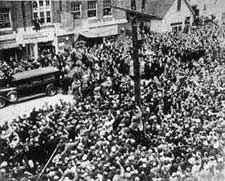
Ford Hunger March - March 7, 1932 The march began on Detroit’s
East Side and
proceeded 10 miles
seeking relief during the Great Depression. Facing
hunger and evictions,
workers had formed neighborhood Unemployed
Councils. Along the
route, the marchers were given good wishes from
Detroit Mayor Frank
Murphy as well as two motorcycle escorts, and
thousands joined the
marchers along the route.
At the Detroit
city limit, the marchers were met by Dearborn police and
doused by fire
hoses. Despite the cold weather, they continued to the
Employment Office
of the Ford River Rouge plant, from which there had
been massive
layoffs. Five workers were killed and nineteen wounded by
police and
company “security” armed with pistols, rifles and a machine gun.
( http://www.peacebuttons.info/E-News/peacehistorymarch.htm
)
1932 Ford Massacre
Henry Ford hated unions. So, in 1914, he introduced a $5 daily
minimum wage before it's time
elsewhere.
But he also used spies and intimidation. Ford employed the world's largest
company
private
police force. They were ex-convicts, gangsters, wrestlers and prize fighters.
In 1932, thousands of unemployed Ford workers marched peacefully
march on the carmaker’s Dearborn
plant, only
to be machine-gunned by Henry Ford’s private army. They start out peacefully,
but are met at the gates by Dearborn
cops who order them back & fire tear-gas bombs.
Members of the crowd begin to
throw rocks & pieces of ice. In response the Ford
Company fire department now
unleashes tons of high-pressure icy cold water on the
marchers from fire hoses. The
police open fire with pistols, rifles & machine guns.
Four were killed, 25 wounded.
Henry Ford fortifies his home with machine gun emplacements
& stockpiles teargas
& ammunition at the Rouge.
( http://eng.anarchopedia.org/March_7 )
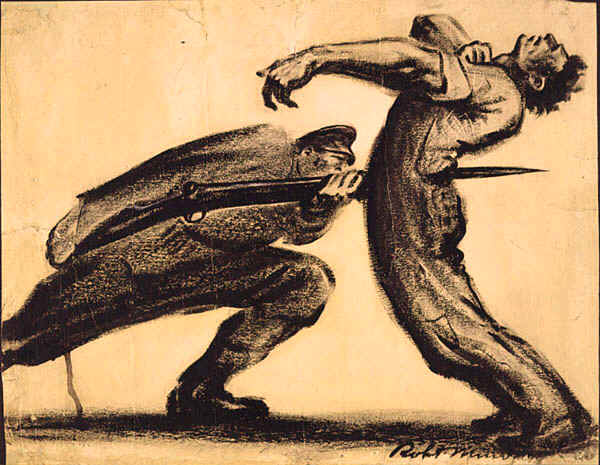
Robert Minor. Pittsburgh (1916)
1941 Ford workers earned 10 cents/hour less than at GM plants They had no
lunch rooms and only
a 10-15
minute lunch break.. They were expected to works as needed on weekends, but got no extra
over-time
or holiday pay. In March 1932, unemployed Ford workers marched on the plant and
were fired
on by Ford security. Four workers were killed. In 1937, union organizers who went
to Gate 4
to distribute union literature were beaten up. The UAW joined with the NAACP and it
membership
boomed. On March 13, 3000 workers sat down to protest the latest firings of union
members. On
March 18, 1841, 6000 workers sat down until the company agreed to rehire
12 fired
unionists. On March 19, another building struck, and the company gave in. Yet on
April 1,
Ford
refused to meet with a union committee in the rolling mill and fired several union
workers.
The rolling
mill workers stopped production, and the strike spread around the plant. Ford called
the
Dearborn police and the UAW leadership and asked them to send the workers back to work.
The UAW
proposed that Ford rehire the fired workers. The company refused. Two hours later the
union
declared the strike official.
Ford's Security and 1000 workers stayed in the plant as strikebreakers.
They were paid $1 an hour,
24 hours a
day. Most were Black-either longtime workers loyal to Ford or new workers brought
in for the
purpose of breaking the strike. But the picket lines showed Black and white
solidarity.
Tens of
thousands of workers joined the picket lines at all the gates. There were daily strike
bulletins,
hourly press statements and 12 radio broadcasts a day. Ten sound trucks got the
message
out. The workers parked their cars in huge barricades, blocking all entrances
to the plant.
The UAW
held a rally attended by 16,000-20,000. Promises of support poured in from workers
at Chrysler
and GM, and from all over the CIO. Homer Martin, a company spy, who posed as the
AFL Ford
leader, charged that the UAW was communist controlled. There was much fighting.
The union
said that 153 workers had required hospitalization since the start of the strike and that
six were in
serious condition.
After one week of the strike, the NLRB ruled that there must be a
collective bargaining
election within 45 days, a departure from the usual 60 days. But the question remained
about
reinstating the eight workers whose firings had kicked off the strike. The governor and
Murray,
head
of the CIO, proposed to reinstate five of them and arbitrate the cases of the other three
later.
Ford
agreed that there would be no reprisals against strikers. There was a mass meeting
of 20,000
to
vote on a settlement. Some opposition arose from those who felt the contract should be won
before settling. But the UAW agreed to postpone other complaints until after the union
election.
The strike was ended and workers went back to work on April 14.
The UAW had a mass meeting to rally support. Sixty thousand
workers and their families
crowded into Cadillac Square in Detroit. On May 21, the election was held on union
representation.
The UAW won overwhelmingly while the AFL got 28 percent of the vote. On June 20, the
contract was signed. It provided for the first dues check-off, seniority, and a grievance
procedure.
It raised wages to correspond to the rest of the auto industry. There was also a clause
prohibiting
discrimination. For the first time, the UAW won a union shop
(Source: http://www.geocities.com/mnsocialist/ford1941.html
)
====================================================================================
Addendum
A number of famous and
important lanor struggles were left out from the discussion
above. They include
discussion of the Molly Maquires,
Cripple
Creek - 1894, Joe Hill, Anthracite
Strike-
191-1911, Sacco and Venzetti, San Francisco General
Strike of 1934..
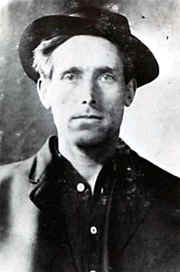
Joe Hill was labor
activist, songwriter,
and member of the Industrial Workers of the World
Because he was a
Wobbly, he was framed, Though one witness ot the murder said he
was not the killer, he
was executed for murder
in a Utah court and kangaroo trial.
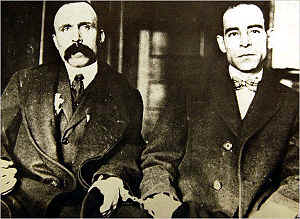
On trumped up charges
and reflecting the ugly and shameful natavism of the day, two Italian workers
were found guilty o f
armed robbery and murder. They were electrocuted in1927.
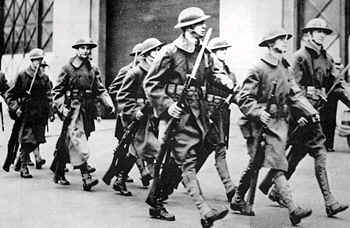
Soldiers of the California National Guard patrolling the Embarcadero in July 1934.
|

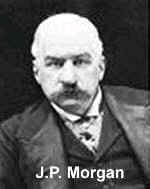 Discussion
of robber barons
Discussion
of robber barons 


 Federal troops frequently
were needed in Idaho, 1892 and 1899.
Federal troops frequently
were needed in Idaho, 1892 and 1899.











